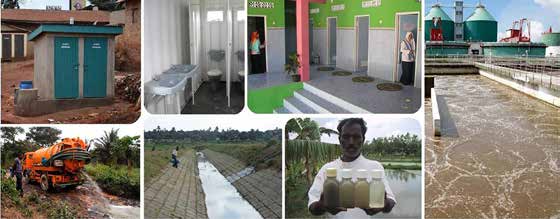Did you know that urban India has to collect, treat and dispose about 38,000 million litres of human waste and waste water per day?
Additionally, the waste from on-site sanitation systems (faecal sludge) is not adequately treated in most Indian cities, thus polluting our environment and exposing the population to adverse health impacts. Estimates show that in the next 20 years, an additional 200 million urban dwellers will have to be serviced. It is indeed a complex and daunting challenge that India will need to respond to much faster than the developed countries did in the past.
The current level of sanitation service in the country is dismal, with over 40 million urban dwellers who regularly defecate in the open. That is why the government’s efforts today are concentrated on building toilets to eliminate open defecation. However, this is just “a stepping stone” – the solution does not lie in only building toilets, for toilets without proper disposal and treatment of the waste don’t really serve the purpose of effective sanitation solution. The issues involved in effective sanitation solutions are twofold: 1) Access to toilets 2) Treatment of waste, before reuse and safe disposal. The challenge is to address the performance of the entire sanitation value chain (containment, emptying, transportation, treatment, and disposal/reuse), which requires a paradigm shift in the way sanitation planning is done in urban India.
The New Paradigm
Urban Local Bodies (ULBs) in India need to deploy all sanitation options available to provide sanitation to all its citizens in the given time frame. The types of sanitation systems for a particular city are dependent on locally specifi c factors like population density, water usage and availability, soil type, water table level, and the priorities of the city, such as coverage, environmental and health benefi ts, elimination of open defecation. All these factors can vary signifi cantly within a city, thereby infl uencing the sanitation requirements and priorities in various parts of the city.
For example, the population density of New Delhi ranges from 15000/sq km to 45000 /sq. km. In such a situation, sewer-based systems may be the optimal solution for high density core areas, whereas it may not be the ideal solution for areas with unpredictable population growth and fast changing sanitation needs. On the other hand, sewer-based systems may not be the most suitable option for fast growing peripheral areas in Bangalore with low water availability because such systems require high capital investments, and large amounts of resources like water and energy for effective operation. On-site/decentralised and lower cost solutions like septic tanks with proper septage management (treatment and disposal) may be more suitable in these areas.
The Portfolio Approach
In order to address the current and future sanitation needs of cities, the sanitation research community recognises the need for a ‘portfolio approach’, emphasising the importance for decision makers to think beyond networked sewer systems to non-networked decentralised/on-site solutions. There is further a need for innovative solutions that are costeffective and fl exible enough to adapt to the changing dynamics of Indian cities. It is important to understand that only technical options do not solve the whole puzzle. Effective solutions are those that also consider non-technical considerations as well, such as the accompanying business models, awareness and information, and stakeholder involvement.
The Knowledge Gap
This approach offers a nuanced look at sanitation where there is a need to have an integrated look at the performance of a sanitation system (impacts on cost, health, environment). However, information and knowledge to understand the performance of different on-site/decentralised sanitation systems are rarely available for decision makers. Common systems might address issues like open defecation, but they do not address septage management and/or safe disposal. It is thus imperative to develop a broad resource base which will enable decision makers to choose from a range of technologies to serve the needs of a city.
 A decision support platform, combing both approaches, is the need of the hour to assist policy makers and ULBs in addressing India’s sanitation woes.
A decision support platform, combing both approaches, is the need of the hour to assist policy makers and ULBs in addressing India’s sanitation woes.
A Decision Support Platform
A good decision support platform for integrated sanitation investment planning would allow the user to compare different types of sanitation systems from fi nancial, social, resource, and logistics perspectives. The platform should allow for regular updates on data or technologies. It should enable:
1. Performance assessment of sanitation systems (beyond toilets)
2. Assessment of the impact of various alternative technologies (beyond networked solutions only)
3. Collaboration and consultation with partners, stakeholders and decision-makers within this sector
4. Comparison of the cost/benefi ts of various sanitation system options and assessment of trade-offs.
Aided by the Bill and Melinda Gates Foundation, CSTEP is currently developing a decision support platform in the form of a visual interactive tool to assist the integrated assessment of alternative sanitation systems (composed of different sanitation technologies). The primary objective is to provide policy makers with appropriate sanitation system options that are suited to local circumstances, including poor and/or informal settlements, which must be rapidly expanded to fi ll current gaps and accommodate urban growth in India.
The tool provides and allows for:
• A GIS enabled user interactive interface for sanitation system planning for a city
• Examination of its impact on the performance of the actions for decision makers(based on inputs provided)
• Assessment of the impact of various technology options in sanitation
• Comparison of a portfolio of technology choices to improve sanitation coverage in the cities for decision makers
• Facilitation for the collaboration and consultation with partners, stakeholders and decision makers within this sector In Indian cities, award is an administrative unit of a city region/city area. A city consists of many wards.
Hence, the approach adopted in developing the tool is based on an understanding of different possible contexts:
1. Ward context (any spatial unit): This determines the information on the ward-the socio-economic, demographic, and geographic characteristics, sanitation systems present, resource availability and any other relevant information needed for choice of sanitation systems.
2. System context: This determines the sanitation systems that are present and relevant for the city with its parameters and respective values.
3. Scenario context: An understanding of the impacts of groups of sanitation systems at ward and city levels through the use of scenarios using ward and city level indicators.
This evaluation approach is an evolving methodology that aims to enhance the conventional urban sanitation investment planning process. Its focus is on alternative technology options to determine the best possible sanitation solutions, keeping in mind not only the feasibility of a project but also the context in which the project is to be implemented.
This approach will be relevant to decision-makers infl uencing sanitation infrastructure decisions, by being exposed to a range of sanitation systems available and at the same time see the impact of their decision on various indicators like accessibility, coverage, cost, environment and health. Other stakeholders such as technology developers and practitioners can get an overview of the broad choices available and can also refer to this approach to highlight the benefi ts of their technologies (as a system/or part of a system), through their choice of indicators.








Great, artice, very inspiring for latín american contexto as well